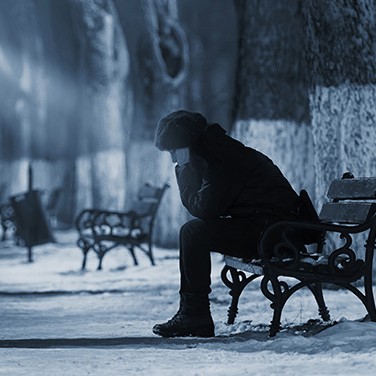The Science Behind Seasonal Depression
By Christina Phillis
As the days get shorter and the sun seems like an infrequent visitor, some people experience a form of depression called seasonal affective disorder (SAD). With SAD, symptoms typically occur during fall and winter and lessen or stop during spring and summer. Although it’s rare, some experience symptoms of depression that start in the summer and end during the colder months.
Feeling depressed, hopeless, or worthless, having low energy, losing interest in activities once enjoyed, problems sleeping, and changes in appetite are some of the symptoms of SAD.
A person is diagnosed with SAD when they’ve experienced depression that is linked to specific seasons for at least two years, according to the National Institute of Mental Health (NIMH).
“You want to establish that there has been, over the years, a pattern of the mood change at certain times of year. It’s always complicated because people want to attribute it simply to the time of year and the changes in light cycles. Unfortunately, it coincides with other things that go on at the same time, such as the holiday season and a change in weather,” said Sanford H. Auerbach, MD, Director, Sleep Disorders Center and Associate Professor of Neurology, Psychiatry and Behavioral Neurosciences, Boston University School of Medicine.
Contributing Factors of Seasonal Affective Disorder
When the bright days of summer give way to the darker days of fall, our bodies and minds go through changes in response. This combination of environmental, mental, and biological factors interact and contribute to the symptoms associated with SAD.
“Light travels from our eye to the deep part of the brain in the hypothalamus. From there, there are pathways to different parts of the brain related to mood and sleep. There’s a real biology underlying it that’s not that clear all the time,” said Dr. Auerbach.
Serotonin Levels
Serotonin is a neurotransmitter that affects mood. When serotonin levels in the brain are low, this can lead to depression. Increased levels of SERT, a protein that helps to transport serotonin, can decrease the level of serotonin in the brain.
“Serotonin levels and epinephrine levels are all regulated in part by exposure to light,” said Dr. Auerbach.
According to a study featured in the Medical News Today article“Seasonal depression 'caused by increased levels of serotonin transporter protein’,” participants with SAD showed 5% higher levels of SERT in the winter.
Melatonin Levels
Overproduction of melatonin is also linked with SAD, according to the Depression Research and Treatment report “Seasonal Affective Disorder: An Overview of Assessment and Treatment Approaches.” Melatonin is the hormone that tells our bodies to get sleepy in response to darkness. As a result of the days getting darker in winter, melatonin production increases.
“Melatonin is not necessarily responsible for the mood changes, but it may be more of a product of the changes in light and one of the markers of the disorder,” said Dr. Auerbach.
Circadian Rhythms
The body’s internal clock, or circadian rhythm, can be thrown off by the combination of decreased serotonin and increased melatonin. Circadian rhythms respond to changes in light and dark that occurs throughout the day and seasonally. Certain studies have found that patients with SAD have a more difficult time adjusting to seasonal changes in day length because their circadian signal is timed differently.
Brain Circuitry
More recently, scientists at Brown University discovered a brain circuit that sends signals between light-sensing cells in the retina and areas of the brain that affect mood. According to their study, the shorter days of winter trigger these cells to send signals to the brain that make a person feel depressed.
Treatments for Seasonal Affective Disorder
Depending on the patient and their specific needs, various treatment options can be used alone or in combination.
“The two biggest treatment options would be to try to take advantage of light or medication. We generally try to avoid pharmacological methods if possible. Doing all of the things people do for depression helps — exercise, minimizing alcohol, getting enough sleep or sleeping less. The real difference with this is the access to light,” said Dr. Auerbach.
Medications & Psychotherapy
Antidepressant medications such as bupropion may be used to increase levels of dopamine, and selective serotonin reuptake inhibitors (SSRIs) can increase serotonin. But these medications can have some side effects. Psychotherapy, or talk therapy, is another alternative, which helps patients identify and change their negative thoughts and learn healthy ways to manage stress.
Light Therapy
Light therapy involves exposure to artificial light that replaces the daylight deficit. The light source is usually a light box with an ultraviolet filter. According to the NIMH, patients suffering from SAD should expose themselves to 10,000 lux of cool-white fluorescent light for 20 to 60 minutes every morning from early fall until spring.
Lifestyle
A variety of lifestyle changes can also help with this disorder, according to HelpGuide, an online resource for mental health and wellness. Regular exercise and time spent outdoors in the sunlight can naturally boost serotonin, endorphins, and other chemicals that make you feel good.
Being more social or taking steps to manage stress can help boost one’s mood, whether it’s meeting up with a friend for coffee or spending time on a favorite activity like painting.
The right combination of treatments is different for everyone. And certain aspects of the disorder may be hard to bring to light, as it remains a complex dance between seasonal, biological, and mental factors.
